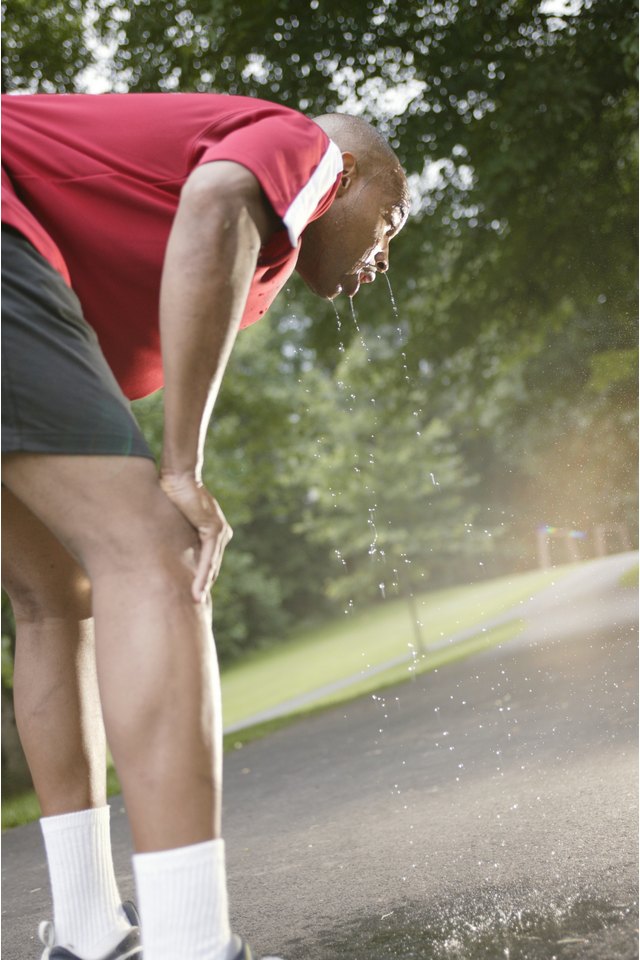Do Oxygen Levels Increase or Decrease With Exercise?

Oxygen levels in your blood are measured by a pulse oximeter device, which can be added to a smart phone along with an app or purchased from a pharmacy or medical supplier. Most healthy adults range from 94 to 98 percent oxygen saturation in their blood, and dropping below 90 percent for an extended period of time can cause loss of brain cells and other serious health risks. Understanding how exercise raises and lowers your blood oxygen level will guide you in your workouts and setting fitness goals.
Impact of Overall Health
Impaired health, particularly of the heart and lungs, can drastically impact your ability to perform certain physical events and exercises. Your body's ability to effectively exchange the carbon dioxide and oxygen as your blood flows throughout is restricted, resulting in significant drops in oxygen levels while working out. Because of this, you may require specialized cardiovascular physical and occupational therapy to safely and gradually build up your circulation and lung capacity so you can maintain a stable oxygen level during activity.
Exercise Affects Oxygen Levels
Your fitness level will be the largest determinant of the effect exercise has on your oxygen level. In most cases, if you work out regularly, you will be able to continue to work out at that level with approximately stable oxygen saturation levels. However, if you suddenly increase the length or the intensity of your workout, you will most likely notice that your oxygen levels will drop during a workout routine. Extreme shortness of breath and other symptoms like dizziness and nausea can indicate that your oxygen level has dropped below an acceptable level and you have strained your body too much.
Determining Your Oxygen Level
While pulse oximeters provide the most accurate reading of oxygenation levels, there are other tools you can use to determine if your workout level is safe. For moderate-intensity activity, you should still be able to speak a five-word sentence without taking a breath. If you are unable to do this, then you should reduce the intensity of your exercise. For maximum-intensity activities, you should still be able to speak two to three words without taking a breath. If you are unable to speak, you are likely approaching a dangerously high heart rate combined with a reduced oxygen level and should significantly reduce your intensity immediately.
How to Improve Your Oxygen Levels
Aside from the extreme of hyperventilation, which will increase your oxygen to 100 percent and not allow your body to exchange the carbon dioxide out of your bloodstream, increasing your oxygen levels while working out will help you to work out longer, at a higher intensity and with fewer breaks. To improve your oxygen level if you are feeling winded, adopt a pursed-lip breathing technique. Breath in through your nose, allowing your inhalation to slow a bit, giving your body the chance to exchange oxygen and carbon dioxide in your blood. Make sure to take a long, deep, full breath as you inhale, and then exhale fully to get rid of the carbon dioxide. Purse your lips as you exhale to allow a controlled amount of air to leave your body at time. It is similar to breathing in as though you were trying to smell a full bouquet of roses and then breathing out to blow out a cake full of candles.
References
- Nursing Times: Managing Hypoxia and Hypercapnia
- Mobi Health News: iHealth Adds Smartphone-Enabled Glucometer, Pulse Ox
- Chest Journal: Predictors of Oxygen Desaturation During Submaximal Exercise in 8,000 Patients
- Society for Technology in Anesthesia: Oxygen Saturation and Heart Rate During Exercise Performance
- The Lancet: Effect of Breathing Rate on Oxygen Saturation and Exercise Performance in Chronic Heart Failure
Writer Bio
Melissa Sabo is an occupational therapist who started writing professional guidebooks for all Flagship Rehabilitation employees in 2009. Specializing in applied therapy and exercise for non-medical readers, she also coauthored a manual on wheelchair positioning. She graduated from the University of Pittsburgh with a Bachelor of Science in occupational therapy.
